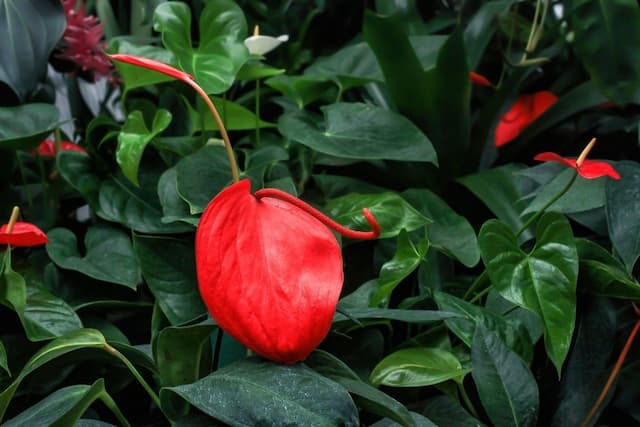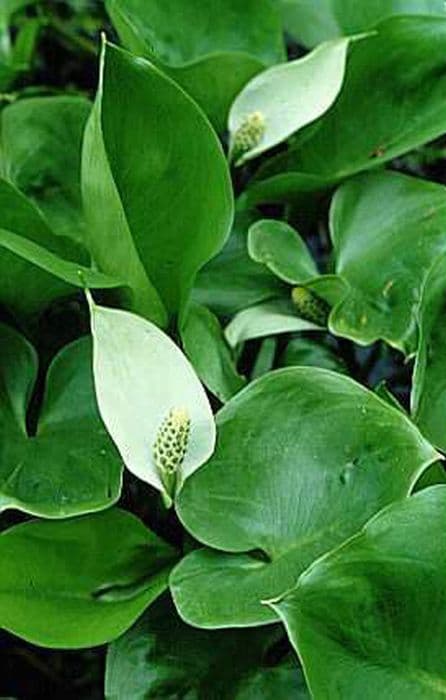Cobra Lily Arisaema nepenthoides

ABOUT
Arisaema nepenthoides, commonly known as the Cobra Lily, is a distinctive and striking plant. This plant has a unique flower structure that is shaped like an elongated flask with a curved hood, which often draws comparisons to the hood of a cobra, hence its common name. The flower is typically a mix of purple, white, and green, with dark purple or brownish stripes decorating the interior, creating a remarkable pattern. The spathe, which is the showy part of the flower, shields the internal spike-like structure called the spadix. The leaves of the Cobra Lily are quite intricate, usually divided into three leaflets which radiate from a central point, similar to the fingers on a hand. These leaflets are deep green, often with a glossy appearance, and may have wavy or undulating edges giving them a lush, full look. The texture of the leaves can be smooth to slightly velvety. The plant has a tuber underground, which is its storage and perennial organ. This tuber allows the plant to survive through the seasons when the above-ground portions die back. The overall impression of the Cobra Lily is one of exotic elegance, often inspiring a sense of mystery due to its uncommon flower design and the dramatic, sweeping lines of its foliage.
About this plant
 Names
NamesFamily
Araceae
Synonyms
Himalayan Cobra Lily, Cobra Arum
Common names
Arisaema luridum var. nepenthoides, Arum nepenthoides.
 Toxicity
ToxicityTo humans
The Himalayan Cobra Lily is known for its toxicity. It contains calcium oxalate crystals which, when ingested, can cause severe irritation to the mouth, throat, and gastrointestinal tract. Symptoms of poisoning include a burning sensation in the mouth, swelling of the lips and tongue, difficulty swallowing, nausea, vomiting, and diarrhea. Ingesting any part of the Himalayan Cobra Lily can lead to these symptoms, and it is advised to seek medical attention if any parts are consumed.
To pets
The Himalayan Cobra Lily is also toxic to pets due to the presence of calcium oxalate crystals. If a pet ingests any part of this plant, they may experience symptoms similar to those in humans, such as oral irritation, excessive drooling, pawing at the mouth, reduced appetite, vomiting, and difficulty swallowing. In severe cases, swelling may obstruct the airway. It is important to prevent pets from accessing the plant and to consult a veterinarian immediately if any parts are ingested.
 Characteristics
CharacteristicsLife cycle
Perennials
Foliage type
Deciduous
Color of leaves
Green
Height
1-2 feet (0.3-0.6 meters)
Spread
1-2 feet (0.3-0.6 meters)
Plant type
Bulb
Hardiness zones
6
Native area
Himalayas
Benefits
 General Benefits
General Benefits- Ornamental value: Arisaema nepenthoides, also known as the Himalayan Cobra Lily, is known for its unique and striking appearance, making it an interesting addition to gardens and landscaping projects.
- Biodiversity support: As a native species in certain regions like the Himalayas, it plays a role in maintaining local biodiversity and supporting the ecosystem.
- Educational interest: The plant's unusual morphology, with its hooded spadix and pronounced spathe, can be of interest for educational purposes in botany and ecology.
- Cultural significance: In areas where it is native, it may hold cultural importance and be used in traditional practices or local folklore.
- Wildlife habitat: It can provide habitat and food for various insects, which in turn can attract birds and other wildlife to a garden setting.
- Soil enrichment: Like many plants, it can contribute to soil health through natural processes like leaf litter decomposition, potentially enhancing soil fertility.
 Medical Properties
Medical PropertiesThis plant is not used for medical purposes.
 Air-purifying Qualities
Air-purifying QualitiesThis plant is not specifically known for air purifying qualities.
 Other Uses
Other Uses- Arisaema nepenthoides, also known as Cobra Lily, can be used as a unique ornamental plant in gardens due to its distinctive appearance that resembles a cobra ready to strike.
- The tubers of Cobra Lily can be ground to make a paste for cosmetic purposes, such as natural face packs, although caution is advised due to possible skin irritation.
- The sturdy leaf stalks of the Cobra Lily can be utilized in crafting small items like decorative pens or supports for lightweight garden ornaments.
- Fibre extracted from the leaves and stems may be used in the making of eco-friendly crafts, such as baskets or mats.
- The Cobra Lily's unusual inflorescence can be used as a natural model or inspiration for artists and designers creating works with botanical themes.
- The seeds of Cobra Lily, when dried, can be used in jewelry making as beads, though they do not have a long-term durability.
- Teaching botanical concepts can be more engaging with the Cobra Lily as a living example of plant adaptation and unique pollination mechanisms.
- Photographers and nature enthusiasts might use the Cobra Lily as a captivating subject for macro photography due to its intricate structure.
- The sap from the leaves and stems has potential use in traditional textile dyes, though this is not common and should be approached with care for possible allergenic reactions.
- The Cobra Lily can play a role in conservation education programs, emphasizing the importance of preserving native flora and unique species.
Interesting Facts
 Feng Shui
Feng ShuiThe Arisaema nepenthoides, commonly known as Cobra Lily, is not used in Feng Shui practice.
 Zodiac Sign Compitability
Zodiac Sign CompitabilityThe Cobra Lily is not used in astrology practice.
 Plant Symbolism
Plant Symbolism- Mystery - Arisaema nepenthoides, commonly known as Cobra Lily, has a mysterious aura due to its unique, hooded flower shape resembling a cobra poised to strike.
- Protection - The cobra-like appearance of the Cobra Lily gives an impression of defense and guardianship, symbolizing protection.
- Rarity - Being less commonly known and with a distinctive appearance, the Cobra Lily symbolizes uniqueness and rarity in the plant world.
 Water
WaterFor the Arisaema nepenthoides, commonly known as the Cobra Lily, water the plant deeply but infrequently, allowing the soil to almost dry out between waterings. Typically, during the growing season, provide the Cobra Lily with approximately 1 gallon of water every 7 to 10 days, adjusting the frequency according to temperature and humidity. During dormant periods, reduce watering significantly, providing just enough to prevent the soil from becoming completely dry. Always use well-drained soil to avoid waterlogging, as Cobra Lilies are sensitive to root rot from excessive moisture.
 Light
LightThe Cobra Lily thrives in dappled sunlight or partial shade, mimicking its natural woodland habitat. It's best placed in a spot that receives bright but indirect sunlight for most of the day, with protection from the harsh afternoon sun. Avoid deep shade as well as full sun, which can scorch the leaves and inhibit growth.
 Temperature
TemperatureThe Cobra Lily prefers cool to moderate temperatures, thriving ideally between 60 to 75 degrees Fahrenheit. It can tolerate a minimum temperature down to about 50 degrees Fahrenheit and a maximum of around 90 degrees Fahrenheit, but prolonged exposure to temperatures outside this range can be detrimental to the plant's health. Maintain a consistent temperature within this range for optimal growth.
 Pruning
PruningPruning of the Cobra Lily is minimal and typically involves only the removal of dead or yellowing leaves to maintain a tidy appearance and prevent potential disease. The best time to prune is in late fall or early winter, after the plant has gone dormant. Pruning is not necessary for the plant's health but helps enhance its aesthetic appeal.
 Cleaning
CleaningAs needed
 Soil
SoilThe Himalayan Cobra Lily thrives in a well-drained, rich, and loamy soil mix with a pH ranging from 5.5 to 6.5. A blend of two parts peat or coir, one part perlite, and one part fine pine bark would create an ideal soil structure that retains moisture yet allows excess water to escape, preventing root rot.
 Repotting
RepottingHimalayan Cobra Lily should be repotted every two to three years to replenish the soil and accommodate root growth. It's best to repot the plant in the dormant period, after the foliage has died back.
 Humidity & Misting
Humidity & MistingHimalayan Cobra Lily prefers high humidity conditions, with ideal levels ranging between 70-90%. Consistent humidity close to this range helps mimic its native woodland habitat.
 Suitable locations
Suitable locationsIndoor
Place in well-lit area, with high humidity, and well-draining soil mix.
Outdoor
Partial shade, moist soil, protect from strong winds and harsh sun.
Hardiness zone
6-9 USDA
 Life cycle
Life cycleThe Himalayan Cobra Lily, Arisaema nepenthoides, begins its life cycle when its seeds germinate in the soil, typically requiring a period of cold dormancy to break seed dormancy. The seedlings develop into small tubers, which will overwinter and enter into a period of dormancy. In the following spring, the tubers give rise to a single leaf and sometimes a hooded flower known as a spathe, surrounded by a leaf-like bract known as a spadix. The plant is monoecious, with individual plants producing either male or female flowers; it may change sex annually depending on environmental conditions and plant vigor. After pollination, typically by flies attracted to the spadix, the female flowers develop into a cluster of berries that ripen to bright red, containing the seeds for the next generation. Finally, the plant returns to dormancy, retreating back into its tuber form for the next winter season.
 Propogation
PropogationPropogation time
Spring-Early Summer
The most popular method for propagating Arisaema nepenthoides, commonly known as the Cobra Lily, is by means of seed. Propagation time typically begins in autumn after the seeds have ripened. For successful seed propagation, it is crucial to plant the seeds fresh or store them moist for spring planting. Seeds should be sown in a cold frame or a sheltered outdoor spot at a depth of approximately 0.5 inches (1.25 cm). They require a period of cold stratification to break dormancy, which can be naturally provided by the winter cold if planted outdoors. Germination can be erratic, often taking one to two years to occur. The seedlings are initially slow growing and can take several years to reach flowering size.









